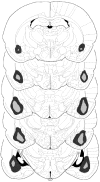The effect of lesions of the basolateral amygdala on instrumental conditioning
- PMID: 12533626
- PMCID: PMC6741878
- DOI: 10.1523/JNEUROSCI.23-02-00666.2003
The effect of lesions of the basolateral amygdala on instrumental conditioning
Abstract
In three experiments, we assessed the effect of lesions of the amygdala basolateral complex (BLA) on instrumental conditioning in rats. In experiment 1, the lesion had no effect on the acquisition of either lever pressing or chain pulling in food-deprived rats whether these actions earned food pellets or a maltodextrin solution. The lesion did attenuate, however, the impact of outcome devaluation, induced by sensory-specific satiety, on instrumental performance both when assessed in extinction and when reward was delivered contingent on instrumental performance. In experiment 2, evidence was found to suggest that the lesioned rats differed from shams in their ability to encode the specific action-outcome contingencies to which they were exposed during training: lesioned rats failed to adjust their performance appropriately when the action-outcome contingency was degraded. These effects were not caused by an inability of BLA lesioned rats to discriminate the two instrumental actions; these rats were similar to shams in their acquisition of a heterogeneous instrumental chain involving lever pressing and chain pulling (experiment 3). In experiment 4, however, lesions of the BLA were found to produce a deficit in the ability of rats to use the specific properties of the instrumental outcomes used in the previous experiments to discriminate rewarded from unrewarded actions in a free operant discrimination situation. Together these results suggest that in instrumental conditioning, the BLA mediates outcome encoding, specifically relating the sensory features of nutritive commodities to the emotional consequences induced by their consumption.
Figures







References
-
- Adolphs R, Tranel D, Damasio AR. The human amygdala in social judgement. Nature. 1998;393:470–474. - PubMed
-
- Baldwin AE, Holahan MR, Sadeghian K, Kelley AE. N-methyl-d-aspartate receptor-dependent plasticity within a distributed corticostriatal network mediates appetitive instrumental learning. Behav Neurosci. 2000;114:84–98. - PubMed
-
- Balleine BW. The role of incentive learning in instrumental performance following shifts in primary motivation. J Exp Psychol Anim Behav Proc. 1992;18:236–250. - PubMed
-
- Balleine BW. Incentive processes in instrumental conditioning. In: Mowrer R, Klein S, editors. Handbook of contemporary learning theories. LEA; Hillsdale, NJ: 2001. pp. 307–366.
-
- Balleine BW, Dickinson A. Role of cholecystokinin in the motivational control of instrumental action in rats. Behav Neurosci. 1994;108:590–605. - PubMed
Publication types
MeSH terms
Grants and funding
LinkOut - more resources
Full Text Sources
